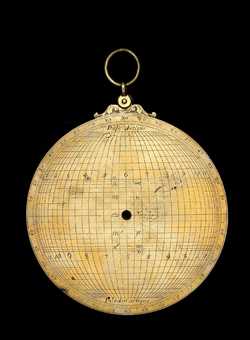Universal
The back contains a universal with a De
Rojas projection. The universal contains the following:
|
Angle of inclination |
Direction of inclination |
Labelled |
Language |
Script |
Line style |
Notes |
| Equator |
N/A |
N/A |
|
|
|
Dotted |
|
| Tropic of Cancer |
N/A |
N/A |
The hour lines are numbered 1 to 12 along this
tropic |
Numbers |
Numbers, engraved |
Plain |
|
| Tropic of Capricorn |
N/A |
N/A |
The hour lines are numbered 1 to 12 from the
right |
Numbers |
Numbers, engraved |
Plain |
|
| Arctic circle |
N/A |
N/A |
Pole Artique |
French |
Italic |
Plain |
The circle (often represented as a line or arc) at
66.5°. These are commonly found on universal
projections |
| Arctic circle |
N/A |
N/A |
Pole Antartique |
French |
Italic |
Plain |
The circle (often represented as a line or arc) at
66.5°. These are commonly found on universal
projections |
The universal contains the following meridians:
| Interval |
Style of line |
Number style |
Description |
| 15° |
Plain |
European Modern |
The hour lines are numbered and dotted |
The universal contains the following parallels:
| Range |
Interval |
Style of line |
Number style |
Description |
| |
5° |
Plain |
N/A |
The parallels are spaced closer between the
tropics |
The universal contains scales of the following types:
| Type |
Range & Units |
Numbered |
Geometry |
Location |
| Degree |
0 - 90, Degrees |
Every 10 degrees |
Circular, concentric |
The entire outer circle on the back of an
astrolabe. |
| Zodiacal
signs |
Aries - Pisces, Zodiacal sign |
Not numbered |
Linear |
The scales found along the central meridian on
universals, usually a zodiac |
Stars
The universal contains the following stars.
Click on the star name or modern star name to search for
other astrolabes with the same star.
Star name
(on instrument) |
Modern star
(if known) |
Mediation |
Declination |
Pointer |
